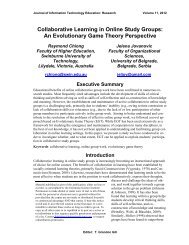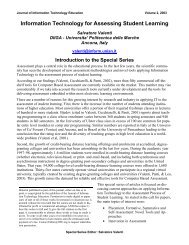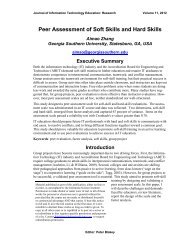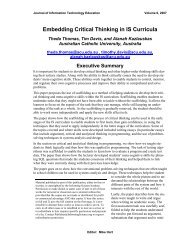Does Math Achievement h'APP'en when iPads and Game-Based ...
Does Math Achievement h'APP'en when iPads and Game-Based ...
Does Math Achievement h'APP'en when iPads and Game-Based ...
Create successful ePaper yourself
Turn your PDF publications into a flip-book with our unique Google optimized e-Paper software.
The Impact of <strong>iPads</strong> on <strong>Math</strong> <strong>Achievement</strong><br />
Q1. What, if any, difference exists in mathematics achievement among fifth- grade students<br />
in a small, rural Virginia school district as measured by the fifth-grade mathematics<br />
SFAW Virginia SOL aligned assessment for students in the group in which <strong>iPads</strong> were<br />
used in a 1:1 setting for mathematical instruction as compared to students in the group in<br />
which <strong>iPads</strong> were not used?<br />
Literature Review<br />
Many students in the 21st century operate portable music players, h<strong>and</strong>held gaming systems, <strong>and</strong><br />
cell phones. The use of mobile technology has become almost second nature to many students,<br />
but these devices are not readily available in schools (O’Brien & Scharber, 2010; Shuler, 2009).<br />
Researchers have encouraged the use of technology in the classroom since the early 20th century<br />
(Amin, 2010; Ross et al., 2010). In the 1940s, overhead projectors were considered the superior<br />
audio-visual media device (Amin, 2010). Later, televisions <strong>and</strong> video home system tapes were<br />
used to provide high quality instructional material (Nugent, 2005). More recently, teachers have<br />
used a variety of h<strong>and</strong>held technologies such as iPods, laptops, <strong>and</strong> smart phones to increase engagement<br />
<strong>and</strong> student learning (Ash, 2011; Banister, 2010; Donovan, Green, & Hartley, 2010;<br />
Franklin, 2011; Granberg & Witte, 2005; Hill, 2011; Li & Pow, 2011).<br />
Academic leaders have invested billions of dollars in educational technologies to improve teaching<br />
<strong>and</strong> learning (Bebell, O’Dwyer, Russell, & Hoffmann, 2010; Cuban, 2001). Technology has<br />
become apparent in many K-12 classrooms, yet very few researchers have focused on the effect<br />
of technology in the elementary mathematics setting. Technology could be vital to creating authentic<br />
learning opportunities (Allsopp, Kyger, & Lovin, 2007). Numerous academic studies<br />
have shown the significant positive correlation between technology, student learning, <strong>and</strong><br />
mathematics achievement (Alagic, 2003; Berk, 2010; Hamilton, 2007; Hubbard, 2000; Mendicino<br />
& Heffernan, 2007; National Council of Teachers of <strong>Math</strong>ematics, 2008; Park, 2008;<br />
Rosen & Beck-Hill, 2012). Hamilton (2007) found that the incorporation of technology was correlated<br />
with improved student mathematics achievement. Rosen <strong>and</strong> Beck-Hill (2012) reported<br />
educational technology could assist in closing the achievement gap <strong>and</strong> incorporate higher order<br />
thinking skills.<br />
Since 2010, tablet computers like the iPad have been both the most recent <strong>and</strong> the most popular<br />
h<strong>and</strong>held game-based learning devices (Buckley, 2010; Castelluccio, 2010; Hill, 2011; Murphy,<br />
2011; Price, 2011; Stevens, 2011). The iPad is a 0.34-inch thick, 1.33-pound, multitouch-screen<br />
tablet computer advertised as a device that could revolutionize learning (Buckley, 2010; Hill,<br />
2011). Technology-focused students enter classrooms daily nationwide; therefore, the market for<br />
the iPad in education could be expansive (Stevens, 2011).<br />
The iPad is a high dem<strong>and</strong> commodity in schools for a variety of reasons. First, the iPad has a<br />
user-friendly processing system so individuals of all ages could use the device easily (Buckley,<br />
2010; Price, 2011; Wang, 2010). Second, the lightweight h<strong>and</strong>held mobile device could be transported<br />
as a replacement for heavy textbooks (Buckley, 2010; Stevens, 2011). Third, the iPad is<br />
capable of high-speed, wireless Internet connections for web-based searching (Murray & Olcese,<br />
2011; Price, 2011). Aside from having Internet access, students have enjoyed the many gamebased<br />
applications, or apps, offered on their mobile devices. Teachers have started using iPad<br />
educational game-based applications, multitouch screen, <strong>and</strong> multisensory capabilities to engage,<br />
introduce, practice, <strong>and</strong> reinforce learning concepts (Castelluccio, 2010; Hill, 2011; Murphy,<br />
2011; Murray & Olcese, 2011; Price, 2011; Stevens, 2011).<br />
Visionary mobile learning devices, such as the iPad, are expected to have a valuable role in 21st<br />
century learning if teachers <strong>and</strong> students could properly utilize the device’s potential (Banister,<br />
2010; Bauleke & Herrmann, 2010). Technology, like game-based applications, might “anchor<br />
272










